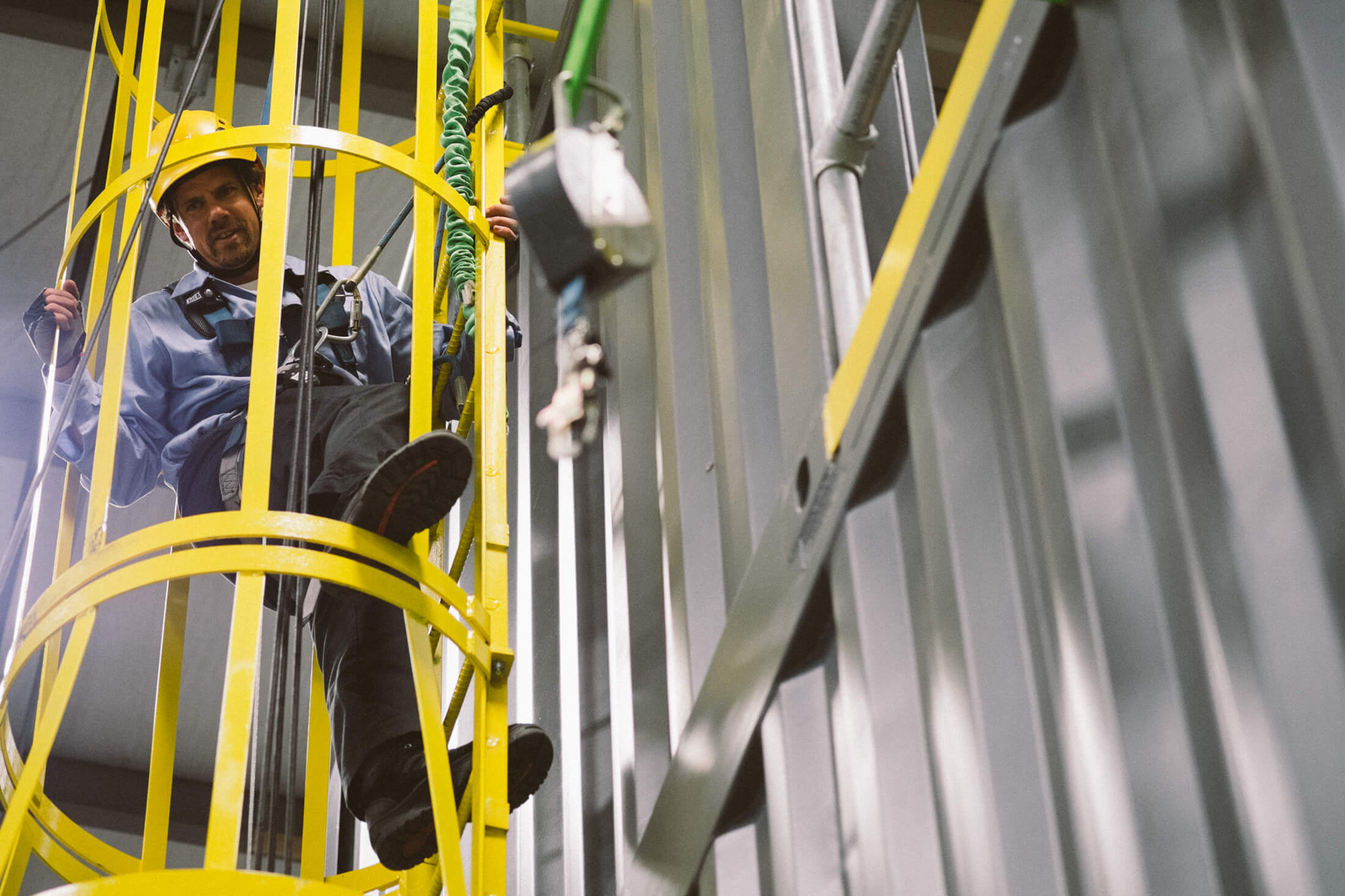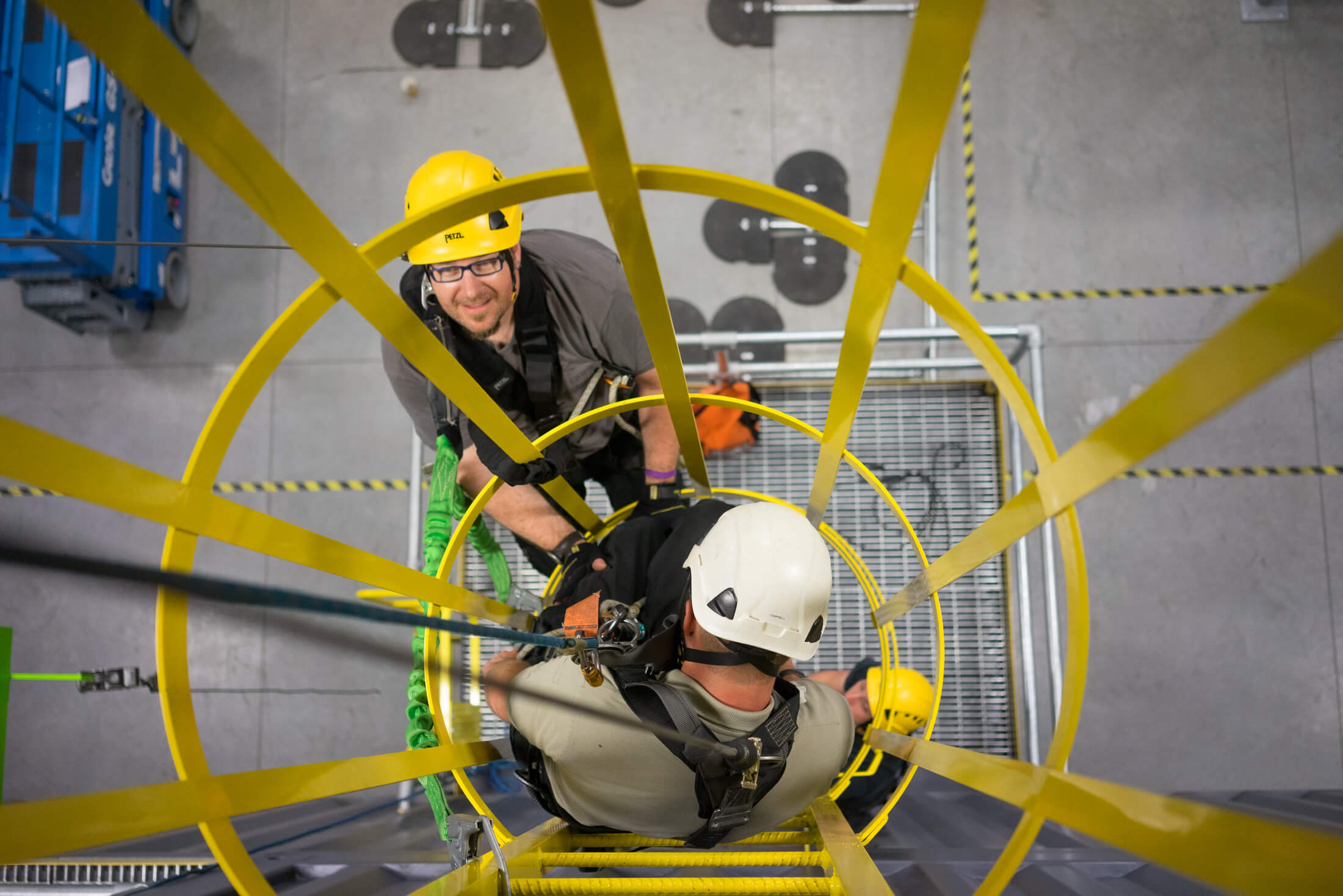
Fixed Ladder Fall Protection Changes
Ladder cages can no longer be used for fall protection
By Kevin Denis, Director of Special Projects
This article is posted with permission from Metal Construction News.
Occupational health and safety regulations have undergone a significant change in 2017 in regards to fixed ladders. Ladder cages can no longer be used for fall protection and their use is going to be phased out over the next several years. Effective November 19, 2018, any newly installed fixed ladder must be equipped with a ladder safety system or a personal fall arrest system (PFAS).
There is good reason for this change. When a fall occurs inside a ladder cage, it is the worker’s body that arrests the fall. Hopefully, the worker’s feet remain on a ladder rung and the fall is stopped when the worker falls backward a few inches. Injuries are minimal when this occurs. Unfortunately, this doesn’t always happen and there is a long history of people falling several feet until a part of their body binds through the ladder rungs or cage.
This often results in significant injury. In extreme cases, the worker falls all the way to the ground or the next platform and the ladder cage (or well) was completely ineffective. Although cages and wells have been compliant for decades, it’s widely known that they can be ineffective and damaging when a fall occurs.


Changes to Regulations
A summary of 1910.28 (b) (9) for fixed ladders greater than 24 feet is as follows:
• Cages cannot be used on any fixed ladder after Nov. 19, 2018.
• A ladder safety system or PFAS is required on any new ladder installation after Nov.19, 2018.
• If a ladder (or section thereof) is replaced, a PFAS or ladder safety system is required.
• By Nov. 18, 2036, all fixed ladders over 24 feet must be equipped with a PFAS or ladder safety system.
There is a little bit of time (November 2018) given to allow existing building and construction projects to be completed that includes ladder cage designs. After November 2018, however, ladder cages cannot be installed on any new installations.
It’s important that architects, engineers, and building planners be aware of this requirement and timeline. Projects, drawings, and building plans should be modified as soon as possible to prevent mistakes and last-minute changes. It’s also important to note that there isn’t any grandfathering of ladder cages. OSHA has provided a 20-year timeline to install PFAS or ladder safety system on all fixed ladders over 24 feet regardless of the age of the ladder.

Ladder Safety Systems
Common and effective fall protection solutions to fixed ladders are ladder safety systems. A cable, pipe, or rail is permanently installed, usually running down the middle of the ladder. The line (cable, pipe, or rail) is anchored at the top of the ladder and/or attached to several rungs along the length of the ladder and is also anchored at the bottom. The ladder safety system manufacturer provides a sleeve that attaches to and travels up and down the line. Wearing a full-body harness with a D-ring around the chest area, workers can attach the sleeve to the harness and climb up and down the ladder. If a fall should occur, the sleeve locks onto the line and the worker is suspended in the harness.
These systems usually lock and stop a falling worker within a couple of feet, usually preventing any severe injuries or long-term disability. They are significantly less expensive than ladder cages and most ladders can be retrofitted with a ladder safety system within a day (once the ladders anchor has been proven and parts ordered). The greatest disadvantage to ladder safety systems is the transition from the top of the ladder to a roof or platform.
Since the connection to the worker’s harness is very short and the top anchor is right in the middle of the ladder, workers often have to disconnect and wiggle through the top anchor and walk-through portion of the ladder.
Personal Fall Arrest Systems
An alternative to ladder systems is a Personal Fall Arrest Systems (PFAS). A PFAS usually has an overhead anchor and a self-retracting lifeline as long as or longer than the length of the ladder. The designs of these systems usually involve some type of overhead anchorage with a dorsal connection to the harness. The overhead anchorage prevents the worker from having to disconnect from the system and provides an unencumbered transition to the structure. The main disadvantage to PFAS is the installation because the overhead anchorage usually requires more work and modifications to the structure than just bolting a ladder system to the existing ladder. Both of these options are feasible and much more effective in arresting falls than ladder cages. The surrounding structure, type, and style of ladder usually dictate which of two options works best.
If you have any questions, contact Gravitec Systems at 1.800.755.8455
